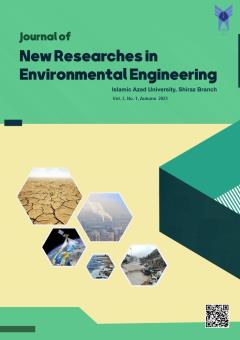H2S Concentration Ranking Around Sewerage Manholes Using Lead Acetate Detector
Subject Areas : Environmental pollution
1 - استادیار، واحد استهبان، دانشگاه آزاد اسلامی، استهبان، ایران
Keywords: H2S, Odor, Sewer, Manhole.,
Abstract :
Introduction: H2S production in sewage collection networks creates many problems, including corrosion of concrete pipes, effects on human health and unpleasant smells. ). Although the sewerage is designed in such a way that the air flows and the H2S gas production does not occur due to the anaerobic process, but sometimes due to improper design, increase in flow rate, pipe clogging or fracture, the H2S gas disperses around the manholes. Monitoring the sewage network by determining the amount of H2S gas can help network repair in a timely manner. Due to the high cost of advanced monitor systems. The continuous management of sewage networks in developing countries requires the development of cheap and economical methods. Materials and Methods: In this research, 150 manholes were selected in Ahwaz city in Iran. Paper tapes impregnated with lead acetate were prepared. They were placed in different areas around and inside the manholes. After collecting samples, they were classified into seven grades according to the amount of obscuration created in the indicators. At the same points as the samples were taken, the amount of H2S gas was measured by the gas meter. And gas concentration limits were determined for each. Results and Discussion: The results showed that lead acetate paper indicator detected a concentration of H2S from zero to 35ppm. The best positioning of the indicators was within the manholes, and the best contact time was set at 24 hours. Conclusion: It is appropriate to use the results of the ranking of indicators in a situation where it is not possible to use advanced sensors to monitor sewage networks.
References:
Cha JH, Kim DH, Choi SJ, Koo WT, Kim ID.(2018) Sub-Parts-per-Million Hydrogen Sulfide Colorimetric Sensor: Lead Acetate Anchored Nanofibers toward Halitosis Diagnosis. Analytical chemistry, 7;90 (15):8769-8775. doi:10.1021 /acs. analchem. 8b01273
Dehghani,M &Taghizadeh MM.(2013). Designing biological filters to eliminate odors in septic tank based on the amount of hydrogen sulfide Jundishapur J Health Sci 2013 ;5(2):79-87
Dehghani M. Taghizadeh MM. Hashemi H (2013) A Preliminary Assessment of Dispersion Level of SO2 in Fars Industrial Region, South of Iran, by GIS. Journal of Environmental and Public Health 2013(1-2):670590 DOI: 10.1155/2013/670590
Franke W., Frechen F.-B., Giebel S. (2009) H2S, VOC, TOC, electronic noses and odour concentration: use and comparison of different parameters for emission
measurement on air treatment systems.Water Sci Technol 59 (9): 1721-1726.https://doi.org/10.2166/wst.2009.127
Ganigue R., Gutierrez O., Rootsey R.,Yuan Z.,(2011) Chemical dosing for sulfide control in Australia: An industry survey.Water Research. 14(19): 6564-6574https://doi.org/10.1016/j.watres.2011.09.054
Guz L, Łagód G, Jaromin-Gleń K, Suchorab Z, Sobczuk H, and Bieganowski A,(2015) Application of Gas Sensor Arrays in Assessment of Wastewater Purification Effects. Sensors 15, 1-21; doi: 10.3390/s150100001
Jiang G., Keller J.,Bond PL (2014) Determining the long-term effects of H2S concentration, relative humidity and air temperature on concrete sewer corrosion . Water Research 56:157-169 https://doi.org/10.1016/j.watres.2014.07.026
Koe LCC (1985) Ambient hydrogen sulfide levels at a wastewater treatment plant. Environmental Monitoring and Assessment, 5:101–108
Mudragaddam M., Kura B, Iyer A, Ajdari E. (2014) Prediction of CO2and H2S Emissions fromWastewater Wet Wells Journal of Geoscience and Environment Protection, 2,134-142.http://dx.doi.org/10.4236/gep.2014.22019
Okabe, S. M. Odagiri, T. Ito and H. Satoh (2007) Succession of sulfur-oxidizing bacteria in the microbial community on corroding concrete in sewer systems. Applied and Environmental Microbiology 73(3), 971-980.
Priyadharsini M.,Iswarya S.,Chandru S., Alagusundaram K.,(2016) Automatic Monitoring and Blockade Removing in Sewer System Using GPS Tracker. International Journal of Advanced Research in Electrical, Electronics and Instrumentation Engineering. Volume 5, Special Issue 1,111-114
Saeedi A, Najibi A, Mohammadi-Bardbori A (2015) Effects of Long-term Exposure to Hydrogen Sulfide on Human Red Blood Cells. International Journal of Occupational Medicine and Environmental Health 6(1):20-5 DOI:10.15171/ijoem.2015.482


